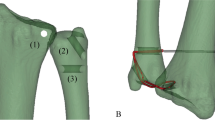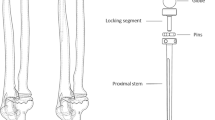Abstract
Introduction
In the reconstruction of distal radioulnar ligaments (DRULs), interference screws can be used for antegrade or retrograde fixation of grafts to the ulna. However, the biomechanics of interference screw fixation are currently unknown. This study aimed to determine the biomechanical effects of these two fixations on the distal radioulnar joint (DRUJ) in a cadaveric model and to investigate the appropriate initial tension.
Materials and methods
A total of 30 human cadaver upper extremities were used, and the DRULs were reconstructed according to Adams’ procedure. First, eight specimens were randomly divided into two groups: antegrade and retrograde, followed by translational testing and load testing. Then, the other eight specimens were divided into the two groups above, and the contact mechanics, including forces, areas, and pressures, were measured. Finally, to investigate the appropriate initial tension, the remaining 14 specimens were fixed with interference screws under different tensions in an antegrade way, and the translational testing was repeated as before.
Results
In the neutral position, antegrade fixation exhibited less translation than retrograde fixation (7.21 ± 0.17 mm versus 10.77 ± 1.68 mm, respectively). The maximum failure load was 70.45 ± 6.20 N in antegrade fixation, while that in retrograde fixation was 35.17 ± 2.95 N (P < 0.0001). Antegrade fixation exhibited a larger increase in contact force than retrograde fixation (99.72% ± 23.88% versus 28.18% ± 10.43%) (P = 0.001). The relationship between tension and displacement was nonlinear (Y = − 1.877 ln(x) + 7.94, R2 = 0.868, P < 0.0001).
Conclusions
Compared with retrograde fixation, the antegrade fixation of interference screws may be a more reliable surgical technique, as it shows a higher failure load and stability. In addition, to avoid the risk of potential arthritis caused by anterograde fixation, we propose an equation to determine the appropriate initial tension in DRUL reconstruction.







Similar content being viewed by others
Data availability
The datasets used and/or analyzed during the current study are available from the corresponding author on reasonable request.
References
Haugstvedt JR, Langer MF, Berger RA (2017) Distal radioulnar joint: functional anatomy, including pathomechanics. J Hand Surg Eur 42:338–345. https://doi.org/10.1177/1753193417693170
Nakamura T, Abe K, Nishiwaki M, Iwamoto T, Sato K (2017) Medium- to long-term outcomes of anatomical reconstruction of the radioulnar ligament to the ulnar fovea. J Hand Surg Eur 42:352–356. https://doi.org/10.1177/1753193416679625
Kwon YW, Park JH, Choi IC, Lee JS, Park JW (2022) Revisional triangular fibrocartilage complex (TFCC) repair using arthroscopic one-tunnel transosseous suture: preliminary results. Arch Orthop Trauma Surg 142:197–203. https://doi.org/10.1007/s00402-020-03613-1
Spies CK, Langer MF, Muller LP, Unglaub F (2020) Reconstruction of the deep fibers of the distal radioulnar ligaments facilitating a tendon graft-Adams’ procedure. Oper Orthop Traumatol 32:262–270. https://doi.org/10.1007/s00064-019-00638-7
Adams BD, Berger RA (2002) An anatomic reconstruction of the distal radioulnar ligaments for posttraumatic distal radioulnar joint instability. J Hand Surg Am 27:243–251. https://doi.org/10.1053/jhsu.2002.31731
Jang E, Dy CJ, Wolfe SW (2014) Selection of tendon grafts for distal radioulnar ligament reconstruction and report of a modified technique. J Hand Surg Am 39:2027–2032. https://doi.org/10.1016/j.jhsa.2014.07.020
Kalson NS, Charalambous CP, Powell ES, Hearnden A, Stanley JK (2009) Tendon graft–ulna fixation in distal radio-ulnar joint stabilisation; biomechanical comparison of three graft-bone fixation methods. Hand (N Y) 4:279–282. https://doi.org/10.1007/s11552-009-9165-z
Luchetti R, Atzei A (2017) Arthroscopic assisted tendon reconstruction for triangular fibrocartilage complex irreparable tears. J Hand Surg Eur 42:346–351. https://doi.org/10.1177/1753193417690669
Carratalá Baixauli V, Lucas García FJ, Martínez Andrade C, Carratalá Baixauli R, Guisasola Lerma E, Corella Montoya F (2019) All-Arthroscopic triangular fibrocartilage complex ligamentoplasty for chronic DRUJ instability. Tech Hand Up Extrem Surg 23:44–51. https://doi.org/10.1097/bth.0000000000000222
Gillis JA, Soreide E, Khouri JS, Kadar A, Berger RA, Moran SL (2019) Outcomes of the Adams–Berger ligament reconstruction for the distal radioulnar joint instability in 95 consecutive cases. J Wrist Surg 8:268–275. https://doi.org/10.1055/s-0039-1685235
Bain GI, Eng K, Lee YC, McGuire D, Zumstein M (2015) Reconstruction of chronic foveal TFCC tears with an autologous tendon graft. J Wrist Surg 4:9–14. https://doi.org/10.1055/s-0034-1399756
Liu B, Fok MWM (2021) The medium term outcomes of an all-arthroscopic triangular fibrocartilage complex foveal reconstruction using tendon graft. Int Orthop 45:1273–1279. https://doi.org/10.1007/s00264-021-04976-9
Ackermann J, Mestriner AB, Merkely G, Ambra FML, Gomoll AH (2020) Femoral interference screw insertion significantly increases graft tension in medial patellofemoral ligament reconstruction. Knee Surg Sports Traumatol Arthrosc. https://doi.org/10.1007/s00167-020-06186-z
Kayaalp ME, Collette R, Kruppa P, Flies A, Schaser KD, Wulsten D, Duda GN, Becker R, Kopf S (2021) A higher initial tensioning force of an ACL graft results in a higher graft force after screw fixation irrespective of the screw diameter: a biomechanical study. Am J Sports Med 49:3825–3832. https://doi.org/10.1177/03635465211047861
Lawler E, Adams BD (2007) Reconstruction for DRUJ instability. Hand (N Y) 2:123–126. https://doi.org/10.1007/s11552-007-9034-6
Carlson GD, Botte MJ, Josephs MS, Newton PO, Davis JL, Woo SL (1993) Morphologic and biomechanical comparison of tendons used as free grafts. J Hand Surg Am 18:76–82. https://doi.org/10.1016/0363-5023(93)90249-3
Spies CK, Niehoff A, Unglaub F, Muller LP, Langer MF, Neiss WF, Oppermann J (2016) Biomechanical comparison of transosseous re-fixation of the deep fibres of the distal radioulnar ligaments versus deep and superficial fibres: a cadaver study. Int Orthop 40:315–321. https://doi.org/10.1007/s00264-015-2986-1
Matsumoto T, Tang P, Fujio K, Strauch RJ, Rosenwasser MP (2018) The optimal suture placement and bone tunnels for TFCC repair: a cadaveric study. J Wrist Surg 7:375–381. https://doi.org/10.1055/s-0038-1661361
Ma CH, Lin TS, Wu CH, Li DY, Yang SC, Tu YK (2017) Biomechanical comparison of open and arthroscopic transosseous repair of triangular fibrocartilage complex foveal tears: a cadaveric study. Arthroscopy 33:297–304. https://doi.org/10.1016/j.arthro.2016.10.027
Low SL, Clippinger BB, Landfair GL, Criner-Woozley K (2020) A Biomechanical evaluation of the DRUJ after distal oblique bundle reconstruction. J Hand Surg Am 45:452.e1-452.e8. https://doi.org/10.1016/j.jhsa.2019.10.011
Malone PS, Cooley J, Morris J, Terenghi G, Lees VC (2015) The biomechanical and functional relationships of the proximal radioulnar joint, distal radioulnar joint, and interosseous ligament. J Hand Surg Eur 40:485–493. https://doi.org/10.1177/1753193414532807
Shaaban H, Giakas G, Bolton M, Williams R, Wicks P, Scheker LR, Lees VC (2007) Contact area inside the distal radioulnar joint: effect of axial loading and position of the forearm. Clin Biomech (Bristol, Avon) 22:313–318. https://doi.org/10.1016/j.clinbiomech.2006.05.010
Pickering GT, Nagata H, Giddins GE (2016) In-vivo three-dimensional measurement of distal radioulnar joint translation in normal and clinically unstable populations. J Hand Surg Eur 41:521–526. https://doi.org/10.1177/1753193415618110
Kataoka T, Moritomo H, Omokawa S, Iida A, Wada T, Aoki M (2013) Palmar reconstruction of the triangular fibrocartilage complex for instability of the distal radioulnar joint: a biomechanical study. J Hand Surg Eur 38:515–522. https://doi.org/10.1177/1753193412461743
Rhee PC, Levy BA, Stuart MJ, Thoreson A, An KN, Dahm DL (2011) A biomechanical comparison of the delta screw and retroscrew tibial fixation on initial intra-articular graft tension. Knee Surg Sports Traumatol Arthrosc 19:781–786. https://doi.org/10.1007/s00167-010-1366-z
Koga H, Muneta T, Yagishita K, Watanabe T, Mochizuki T, Horie M, Nakamura T, Otabe K, Sekiya I (2015) Effect of initial graft tension on knee stability and graft tension pattern in double-bundle anterior cruciate ligament reconstruction. Arthroscopy 31:1756–1763. https://doi.org/10.1016/j.arthro.2015.03.012
Kirwan GW, Bourke MG, Chipchase L, Dalton PA, Russell TG (2013) Initial graft tension and the effect on postoperative patient functional outcomes in anterior cruciate ligament reconstruction. Arthroscopy 29:934–941. https://doi.org/10.1016/j.arthro.2013.01.021
Sakakibara Y, Teramoto A, Takagi T, Yamakawa S, Shoji H, Okada Y, Kobayashi T, Kamiya T, Fujimiya M, Fujie H, Watanabe K, Yamashita T (2020) Effect of initial graft tension during anterior talofibular ligament reconstruction on ankle kinematics, laxity, and in situ forces of the reconstructed graft. Am J Sports Med 48:916–922. https://doi.org/10.1177/0363546520902725
Nagata H, Hosny S, Giddins GE (2013) In-vivo measurement of distal radio-ulnar joint translation. Hand Surg 18:15–20. https://doi.org/10.1142/S0218810413500032
Hess F, Farshad M, Sutter R, Nagy L, Schweizer A (2012) A novel technique for detecting instability of the distal radioulnar joint in complete triangular fibrocartilage complex lesions. J Wrist Surg 1:153–158. https://doi.org/10.1055/s-0032-1312046
Nishiwaki M, Nakamura T, Nagura T, Toyama Y, Ikegami H (2008) Ulnar-shortening effect on distal radioulnar joint pressure: a biomechanical study. J Hand Surg Am 33:198–205. https://doi.org/10.1016/j.jhsa.2007.11.024
Acknowledgements
The authors would like to thank Jiong Yu for his contributions to this study.
Funding
This study was supported by wuxi “Taihu Talent Plan” high-level medical and health talents.
Author information
Authors and Affiliations
Contributions
All the authors (FMG, XDF, GZ, XYP, FX, QWY, and JYM) contributed to the study conception and design. Material preparation, data collection and analysis were performed by FMG, XDF, GZ, XYP, FX, and QWY. The first draft of the manuscript was written by FMG and critically revised by JYM. All the authors read and approved the final manuscript.
Corresponding author
Ethics declarations
Conflict of interest
The authors have no conflicts of interest to declare.
Ethical approval
The study was approved by the Ethics Committee of Wuxi 9th People’s Hospital Affiliated to Soochow University.
Additional information
Publisher's Note
Springer Nature remains neutral with regard to jurisdictional claims in published maps and institutional affiliations.
Rights and permissions
About this article
Cite this article
Gu, F., Fang, X., Zhao, G. et al. Biomechanical evaluation of interference screw fixation techniques for distal radioulnar ligament reconstruction: a cadaveric experimental study. Arch Orthop Trauma Surg 142, 2111–2120 (2022). https://doi.org/10.1007/s00402-022-04432-2
Received:
Accepted:
Published:
Issue Date:
DOI: https://doi.org/10.1007/s00402-022-04432-2




